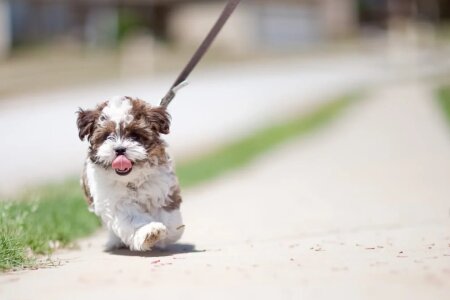Foxhound (English Foxhound)
Overview
Foxhounds are bred to hunt in packs and are not often kept as family pets until they retire. This pack hound uses its sense of smell to find and pursue prey. The Foxhound is a large, strong and social dog with a huge amount of energy and stamina. Traditionally the Foxhound was used for hunting foxes as part of a mounted hunt but now they take part in drag hunts and help get rid of pests on farms. The breed is still widely kept as an outdoor dog that is kept in packs in kennels but Foxhounds are becoming more popular as domestic pets too. The Foxhound is a well-balanced and good looking dog that has an athletic body.
Physical Appearance
The Foxhound is a large dog that has an athletic appearance. The breed looks well balanced and their head is in proportion with the rest of their body. The Foxhound has a square muzzle with large nostrils, their medium eyes are usually brown or hazel and have an alert expression. The ears of a Foxhound are long, they are set high and hang down close to the hounds head. The Foxhound has a strong jaw, deep chest and level back. They have a strong tail that is set high and held high. Foxhounds are well muscled and have powerful legs and strong well-padded paws.
A Foxhound’s coat is smooth, short and weatherproof. This coat offers the Foxhound protection against the elements and is usually white with black, brown, lemon, red, tricolour or mottle colourings.
How big do Foxhounds get?
Character Traits
The Foxhound has a huge amount of energy and stamina, they can keep up with horses and can be on the go all day. This is a breed that wants to be outside on the go and as a pack dog, thrives on company. Foxhounds are loyal and affectionate but their strong hunting instincts mean they will follow scents that they pick up without a second thought. The Foxhound is a playful character, the breed is intelligent and can often figure out how to get their own way. Foxhounds need strong leadership and are not the kind of breed that will spend the day quietly laying on the sofa, they want to be active and doing things outside as much as possible.
Are Foxhounds intelligent? Yes.
Are Foxhounds affectionate? Yes.
Do Foxhounds have high or low energy levels? High energy levels (5/5).
Are Foxhounds loyal? Yes.
Are Foxhounds playful? Yes.
Are Foxhounds aggressive? No.
Are Foxhounds easy to train? No, training them takes time and patience.
Are Foxhounds good guard dogs? No.
Ability to Socialise
The Foxhound is a highly social dog breed that gets on well with other dogs. Foxhounds are rarely kept on their own and are happiest when in a pack. The breed is not a good choice when you have other smaller animals in the home as Foxhounds have a high prey drive and their instinct will be to chase other animals. Foxhounds get on well with children of all ages, the breed is kind, gentle and playful around kids. When it comes to strangers, Foxhounds might bark but may also be uninterested.
Do Foxhounds get along with other pets? No, they have a strong prey drive so should be kept away from other animals.
Do Foxhounds get along with other dogs? Yes.
Are Foxhounds good with kids? Yes.
Are Foxhounds good with strangers? They may bark at strangers but are never aggressive.
Lifestyle Suitability
Foxhounds are not a good choice for first-time owners as they have specific handling and training needs. Due to the size and energy levels of Foxhounds they are not suitable for apartment living. Foxhounds are noisy dogs that will often bark for the sake of it. The Foxhound is a dog that needs to be in the countryside with plenty of space and an extremely secure garden. The Foxhound is happy to spend long hours outside working and participating in tracking sports. If not kept in a pack, the Foxhound needs to be in a home where their owner is home most of the time as they are never happy when left alone.
Are Foxhounds good for first-time owners? No.
Are Foxhounds hypoallergenic? No.
Are Foxhounds prone to drooling? No.
Are Foxhounds a good breed for apartment living? No.
Do Foxhounds shed a lot? No.
Do Foxhounds bark a lot? Yes.
Can Foxhounds be left alone at home? Yes, for a short period,
Can Foxhounds handle the heat? Yes.
Can Foxhounds handle cold temperatures? Yes.
Are Foxhounds sensitive to loud noises? No.
General Health & Health Issues
Foxhounds have an average life expectancy of 12 - 14 years. The Foxhound is known for being a healthy and robust breed with very few health problems. Foxhounds have no breed-specific health problems. The Foxhound is one of the healthiest dog breeds. They may experience the following health issues:
Kidney Disease - This is a serious condition that can be treated if diagnosed early. Kidney disease can cause weakness, pale gums and excessive drinking and urination. The disease can be diagnosed through blood and urine samples. Treatment can include a specially formulated diet, medication and fluid therapy.
Osteoarthritis - This condition causes painful joints that make moving around uncomfortable and difficult. Arthritis cannot be cured but there are treatment options to slow the progression and manage pain.
Heart murmur - a heart murmur can be heard by a vet and treatment will depend on the severity of the problem but may include monitoring and medication.
Congenital deafness - white coated dogs are more prone to this and dogs can be tested for it. There is no treatment for congenital deafness but dogs can live without their hearing.
How long do Foxhounds live? - 12 - 14 years
Exercise & Play Time
Foxhounds are high energy dogs that need as much time outside off lead as possible, this should be at least 2 hours a day. The breed has a strong hunting instinct so enjoys walking, running and scent work. You could cycle or ride a horse alongside a Foxhound and they will happily run across various terrains. The stamina of a Foxhound is impressive and they will want to exercise whatever the weather.
This is a breed that needs to be in the countryside with lots of open space. It’s important to be aware of the Foxhounds high prey drive and strong urge to follow scents, they do not have the best recall so it is important to work on this so they can spend as much time off lead as possible. Foxhounds need access to a large, secure garden but they do have a reputation for climbing fences and finding ways out so the fencing must be very strong.
How much exercise does a Foxhound dog need? At least 2 hours per day
Do Foxhounds like water play? Yes.
Nutrition & Feeding
Foxhounds are large dogs with big appetites. The Foxhound has a deep chest and is more prone to experiencing bloat and stomach issues so they benefit from smaller portion sizes. Foxhounds need high quality food that is specially made for large dog breeds. A Foxhound puppy needs between 230g - 460g of high-quality dry food per day depending on their age and build. This needs to be split into 3 - 4 portions and offered throughout the day. This is a rough estimate, every dog is unique so it is important to have a personal dietary plan made.
Are Foxhounds prone to weight gain? No.
How much should I feed a Foxhound puppy? Between 230g - 460g of high-quality dry food per day depending on age and build.
How much should I feed an adult Foxhound dog? Between 300 - 430g of high-quality dry food per day depending on weight and activity level.
Care & Maintenance
Grooming: The short coat of a Foxhound is low maintenance. A quick brush once a week will help keep the Foxhound in good condition. It is important to check Foxhounds for injury each day as they can experience scratches, torn nails, embedded thorns, cut pads etc. while running and hunting but may not notice. The coat of a Foxhound sheds throughout the year. It is important to check and clean a Foxhound’s ears regularly to prevent infection.
Emotional Care: Foxhounds are social dogs that are happiest when in a pack. Foxhounds require a lot of exercise and mental stimulation to be happy, this means a lot of walking and scent work. Training a Foxhound is time consuming and they can be stubborn. If a Foxhound doesn’t get the daily exercise and mental stimulation they need they can become frustrated and destructive.
History of the Foxhound
Foxhounds have a long history in the UK where they have been bred for centuries for their impressive hunting skills and stamina. The breed has been around since at least the 16th century and records have been kept throughout their rich breeding history. Their origins are unclear but Foxhounds were bred for key traits including strength, stamina and coat colour. Many Foxhounds in the same pack have the same coat colours.
It is thought Fox Terriers, Greyhounds and Bulldogs were all used to help develop the Foxhound breed. In the 19th century there were 140 registered packs of Foxhounds in the UK. However, since the ban on fox hunting the Foxhound numbers have fallen. There are many breed enthusiasts that keep the breed going but the Foxhound is not as popular as they used to be. Foxhounds are not considered family pets but they are recognised by The Kennel Club. It is becoming more common for Foxhounds to find family homes once they retire but they need experienced owners that know how to handle them.
Interesting Facts About Foxhounds
Foxhounds hunt by scent.
Foxhounds live, train and work in packs.
In 2011 a Foxhound won the World Dog Show in Paris and was the first Foxhound to be invited to compete in the Champion of Champions competition.
Foxhounds have incredible stamina.
Foxhounds were the subject of the Disney film The Fox and the Hound.
Getting a Foxhound Puppy
If you are interested in getting a dog, take a look at our buying guide for information on finding and buying a puppy. This guide will help you avoid scams and bad breeder practices. All breeders on Puppies have been vetted to ensure they are responsible. Take a look at our Foxhound puppy page to find dogs available in your area.
How much does a Foxhound cost to buy? - £800 - £1400
How much does a Foxhound cost to feed? - £40 per month.
How much does insurance for a Foxhound cost? - £35 per month.
As Foxhounds are working dogs there may be retired individuals looking for family homes. Speak to your local dog rescue centre or the associations below about adopting a Foxhound:
Rehome a Foxhound with the Dogs Trust
Talk to Foxhound Welfare UK about adoption











